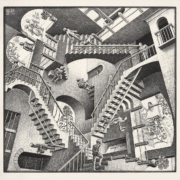A reader’s guide
What does it mean to think about institutions? What is the relationship between functions of thought and institutions? In this special issue, we aim at developing possible answers to these questions.
The real functioning of institutions is a complex phenomenon because it is a human one: it is rooted in the boundaries that people meet when they think, in the emotions that they feel at work, in the needs that they satisfy when they imagine.
The institution is an ensemble of rules, a physical place, a matrix of symbols, but most of all a meeting point of people and their mental representations. Within it, both individual and collective desires, ways of feeling and emotions mingle together. The institution is thus a complex and multidimensional structure in which personal thought and collective logic interact, each with their specificities and criticalities.
The outcome of this interaction is neither pre-determined nor inevitable. In the various contributions of this issue, we reflect on how it can be creative, by containing parasitical and persecutory aspects and opening a space for integration of different, not always convergent, perspectives.
We start from the consideration that institutions lie “in between”.
They are among people, in the trans-personal realm. They represent a meeting point between individual and group thought. They are external but also internal. They always deprive us of something but, at the same time, they offer us opportunities that we would not have otherwise.
From which vertex can we study the relationship with institutions? This question is a common thread which can be used to connect the authors’ thoughts. The contributions to this issue of Funzione Gamma explore heterogeneous perspectives that reflect the personal viewpoint of each author. Nevertheless, they share the same nucleus of key words: thinkability, group, creativity, authority, care, transformation.
In the introduction, I explain why THINKABILITY has been chosen as the complementary background of this editorial project and why it can be helpful in settling an imaginary dialogue among the contributions by the various authors. The introduction frames them within a unique conversation that grows and ramifies but also maintains a fixed point in its complementary background.
By making reference to Kaës, Anna Ferruta introduces the concept of the “necessary institution” and offers her personal interpretations of the functions that it may play for the subject. It is important to recognise and take care of these functions through the active search for a balance between the need for rigidity/structure and that of openness to revision/change that cross the social realm and keep it alive.
From a similar mind-frame, I focus on the conditions that can make the relationship with institutions creative. The bond with institutions articulates the relationship between tradition and change, past and future, social and personal. It is in this conversation with the Other and its History that the individual, as the newborn infant described by Winnicott, has to create a balance from scratch, a modality of relationship that preserves the feeling of being represented.
Mario Perini introduces the reader to organisational consultancy based on a psychoanalytic approach through an exploration of its “object”, the organisation that we see but also the one that we cannot see, being hidden in the unconscious of its members. His analysis highlights the multiple meanings that the concept of organisation contains in the various streams of literature that have defined its boundaries and functions. In the synthesis that the author develops, the organisation maintains its double role of social artefact and living object in the individual mind.
Giovanni Foresti deepens this binocular perspective and stresses the structuring role of authority at the social but also the deeper personal level. Through an articulated excursus, he points at the approaches to authority that have been developed in the psychoanalytic literature and draws attention to the conditions that transform power into authority, or otherwise, deprive it of its legitimacy and creative potential. The difference is made by reciprocity in the two poles of the authoritative relationship: it is necessary that both poles remain active and sympathetic, even if asymmetric, for authority to be perceived as a constructive resource.
Claudio Neri explains how the institution provides the individual with a mirror for his/her needs and responsibilities, whose effectiveness or eventual failings have an impact not only on professional identity, but also on deep, fundamental aspects of the Self, up to the point that an institution that is not able to see the Other can be felt as persecutory, menacing and frustrating. Within this perspective, the triangular relationship between individual, small group and institution can be significant as each vertex can support the others and promote change. The small group can be particularly effective in compensating for institutional failings and sustaining it in critical moments.
Alfredo Lombardozzi widens this perspective by extending the analysis from the small group to the social one. He underlines the importance of a poli-ocular perspective on institutions that takes anthropological, sociological, and even biological aspects into account in order to give value to institutional complexity. In particular, it is through an active interchange relationship with anthropology that the psychoanalytic discourse can be open to its social dimension, thus focusing on the creative but also the destructive tendencies that are embedded in institutions.
Angela Ambrosino reconstructs the complex trajectory of the history of economic thought that has brought economists to change their perspective on institutions over time. It is a trajectory that has been fuelled by interdisciplinary exchanges in which the more orthodox perspective, totally closed to the human dimension of institutions, has gradually shifted to the background in favour of an eclectic approach that gives prominence to the individual, with his specificities, his limits and his complex relationship with the socio-historical environment.
The issue concludes with a thoughtful review by Luciana Zecca of the book “Fare gruppo nelle istituzioni. Lavoro e psicoterapia di gruppo nei contesti istituzionali”, edited by Claudio Neri, Roberta Patalano and Pietro Salemme, published by Franco Angeli (2014).



